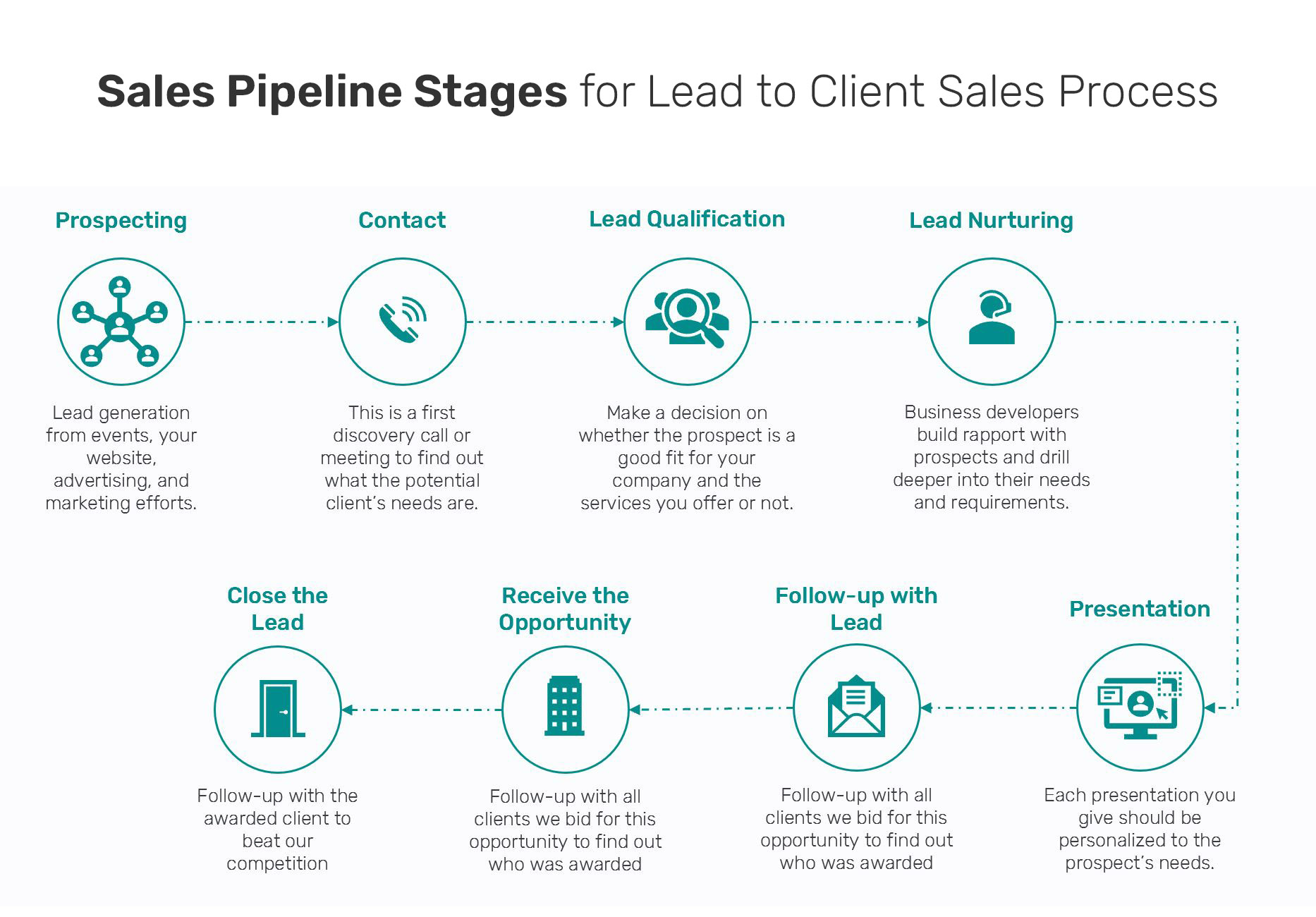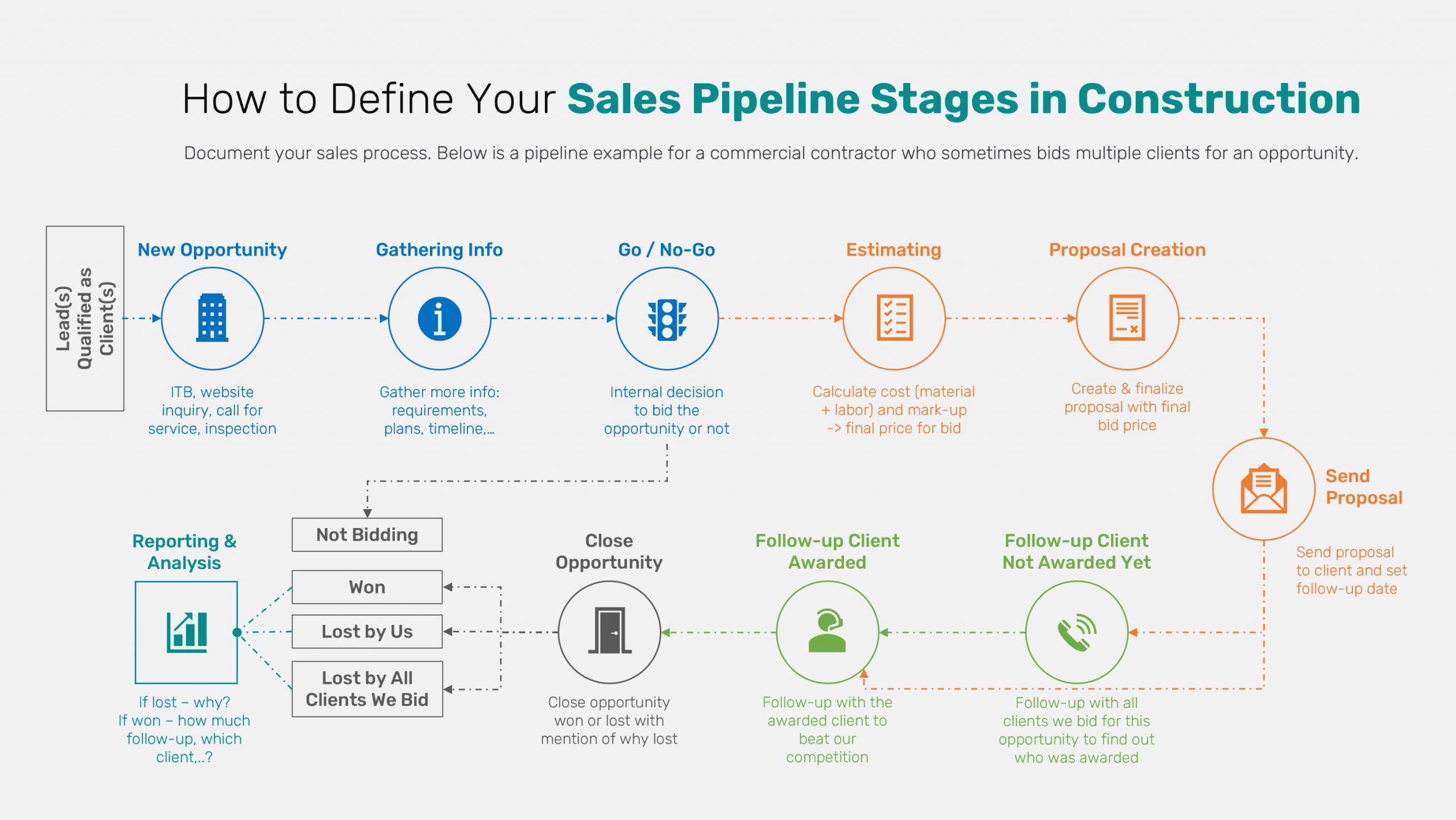If you’re in sales, then you know that the sales pipeline is essential to success. But what exactly are sales pipeline categories? And how can you use them to increase your close rate?
A sales pipeline is simply a system that tracks the progress of potential customers (or leads) as they move through the stages of the funnel. By understanding the different sales pipeline categories, you can better tailor your approach and improve your chances of closing more deals.
Sales Pipeline Categories
Before we dive into each part of the sales process, it’s important to understand what a pipeline is.
A sales pipeline is a collection of all your prospects and customers and is a visual representation of your sales cycle.
A sales process is an organized way of keeping track of your sales. Potential sales are entered into the process as “prospects” and “closed” (won or lost).
A “healthy” sales process includes every single possible sale of your business. The “sales” part of your “customer relationship management” (CRM) system is connected to other processes such as “Customer Success” and “Account Receivable”.
A sales funnel is a visual representation of the steps your prospect takes from first contact to final purchase. By tracking your funnel, you can identify where in the process your lead is getting stuck and where you need to focus your efforts.
Understand the Sales Pipeline Chart and Its Phases
A sales funnel is the path that a customer takes from becoming aware of your product to becoming a paying customer. Most businesses have a sales funnel, even if they don’t know it. By understanding the steps in your funnel, you can better target your marketing efforts, close more deals, and delight your customers.
A typical sales funnel has four main phases.
Lead Generation: Generating new contacts, or potential new customers. This is usually done through marketing, such as blogging, SEO, or PPC.
Lead Nurturing: Developing relationships, or building trust, with your contacts. This is usually accomplished through email campaigns, or other forms of personalized, one-on-one contact.
Closing the Sale: Convincing a prospect to purchase. This usually requires multiple interactions with your prospect and often involves overcoming objections.
Post-Sale Follow-Up: Keeping in touch with your existing customers. This usually involves email, but can also be done through social media, or other channels.
Out-Of-The-Box Sales Pipeline Chart
The out-of-the-box sales pipeline chart shows you how much opportunity is in each phase of the process, and how much money it’s expected to generate.
The opportunity phase in the pipeline is based on the current stage in the sales process.
When the opportunity goes through its process, the Pipeline Phase is set as the {PipelinePhase}.
To see how the pipeline phases are defined, go to your opportunity’s settings page and open up the process flow diagram.
The opportunity sales process has four different stages. Each stage of the process can be mapped and tracked into different categories.
You can customize your sales pipeline by editing or adding steps, and you can change the name for each sales step. This will help you ensure that each step in your sales funnel accurately represents your sales team’s specific processes.
The Pipeline Phase Attribute is calculated based on the category of a stage. Changing the name of a stage will not change this calculation.
The values for each stage in business processes are defined by the values in an option set in the options. The option is named “Stage” and is found in the CRM settings.
When the opportunity is moved to the development stage of your opportunity sales process, the category for that new stage is read by the system.
The Pipeline Phase of a deal is set by the order of the Stage Category, plus the Name of the Stage. This ensures that the phases are in sequential order of the stage in the sales cycle.
If you need to create a new negotiation phase in your sales process, you’ll need to add a new Negotiated status to the Status field in your CRM system. Then, be sure to place this between Proposal and Closing in the sequence of your workflow.
Benefits of a Sales Pipeline
A sales pipeline is a useful tool for tracking your sales team’s progress. It provides you with key information that can help you make decisions. A sales funnel, on the other hand, is not nearly as detailed.
A sales pipeline is important because not only does it provide a comprehensive view of your sales funnel, but it also allows you to optimize your selling process, as well as gain an accurate picture of your revenue stream.
Sales performance is a hot topic, and many studies have looked into what tools, techniques, and strategies have the biggest effect on it.
Sales pipelines are important because they have been shown to lead to a 15% higher revenue growth, as VantagePoint discovered. Companies that take the time to define and master their sales pipeline will be rewarded with greater success.
That’s a big benefit for a simple tool that companies can start using right away!
How to Build a Sales Pipeline
A proper sales funnel should be built carefully.
Before you build your sales pipe, make sure you know everything there is to know about your business, your salespeople, your customer base, your target audience, your target market, your product, and your pricing. This will help you assemble your sales process properly and ensure that your team has all the knowledge they need to close a deal.
Before you build your sales team, it’s helpful to have a few tools at your disposal, such as an email list of prospective customers, a sales pitch, and a CRM.
Prospects List
You’ll want to make a list of people who fit your ideal client profile and who need what you’re offering.
Your list of target buyers should be as specific and as accurate as you can make it.
Make sure to include their name, company, position, how you met, their challenges, and anything else you think is relevant.
Try to assign them a sales cycle or lead lifecycle. It’s fine if you don’t get it right the first time. You can adjust it later.
Sales Process
A clear, systematic, and repeatable process that outlines the exact steps your sales team needs to take to close the deal. By following the simple, yet effective, process of closing, your salespeople will consistently be able to land new clients.
If your team has a clearly defined sales cycle, then you probably already have an idea of all the steps involved. If not, that’s okay. You can map your sales funnel as you build it.
Your sales pipelines are crucial to achieving your financial goals. To design an effective one, you need to first have a clear understanding of your financial objectives. Once you have this, you can map how many new accounts you need in your funnel to reach your goals.
Knowing your conversion rates for qualified leads to closed-won opportunities, you can figure out exactly how many sales you need to make each month.
Team Members
Your sales funnel is how you track the progress of your sales process. By involving your team members in each step, you can make sure that everyone is working towards achieving the same goal. By keeping track of your tasks, you can identify any areas for improvement in your process.
Sales Pipeline Stages Examples
What are the stages of a sales pipeline? Let’s split the sales process into two: the lead-to-client process and the opportunity-to-project process.
Lead to Client
In the lead-to-client sales pipeline, the marketing and business development teams may both be involved.
Your marketing team may be responsible for lead generation from your site and events, while your business development team is responsible for qualifying those leads to become customers.
On the other hand, you may want to have your business development team handle the lead nurture, presentations, and follow-up.
Opportunity to Project
The opportunity to project sales process consists of four or five stages. These stages are color-coded on the graphic below:
What Should Be Included in a Sales Pipeline?
A sales pipeline typically includes the stages that a sales lead goes through from initial contact to conversion. These stages can vary depending on the product or service being sold, but usually include some combination of prospecting, qualifying, needs assessment, solution presentation, and closing.
What Are Sales Pipeline Stages?
Sales pipeline stages are the steps that a salesperson takes to move a potential customer from initial contact to closing the deal. The number and names of stages vary depending on the sales model, but typically include stages such as prospecting, qualifying, needs assessment, solution presentation, and price negotiation.
How Do I Organize My Sales Pipeline?
There is no one-size-fits-all answer to this question, as the best way to organize your sales pipeline will vary depending on the products or services you sell, your target market, and your sales process. However, there are a few general tips that can help you get started.
1. Define your stages. The first step is to identify the different stages in your sales process, from initial contact with a potential customer to closing the deal. This will help you determine what information needs to be tracked at each stage.
2. Create a system for tracking leads. Once you have defined your stages, you need to create a system for tracking leads as they move through the pipeline. This could involve using CRM software or simply creating a spreadsheet with all of the relevant information.
3. Set up reminders and follow-ups. To ensure that nothing falls through the cracks, it is important to set up reminders and follow-ups at each stage.
What is a Basic Sales Pipeline?
The basic sales pipeline is a process that salespeople use to move potential customers through the stages of the buying process. The pipeline typically includes four stages: prospecting, qualification, needs assessment, and proposal.
Conclusion
Sales pipeline categories are an essential part of any sales process. By understanding the different stages and how they work, you can better tailor your approach and increase your chances of success.
Request a Data License and Access the World's People + Company Data
Want 300 million+ profiles at your fingertips? Updated monthly with the data on your own server/host!
Including personal emails, business emails, mobile numbers, mailing addresses and more.
You get net worth, ages, company data, and more.
Use it for cold outreach, paid ad campaigns, direct mail, social selling or even cold calling.
Use it with unlimited access for your own app, outreach campaigns, or as a client service.
Oh, and did I mention we can identify individuals visiting your, or your client's, website?
Contact us for how you can access the entire dataset, on your own server. No more API limits, no price per contact.
[/scWant to help contribute to future articles? Have data-backed and tactical advice to share? I’d love to hear from you!
We have over 60,000 monthly readers that would love to see it! Contact us and let's discuss your ideas!


